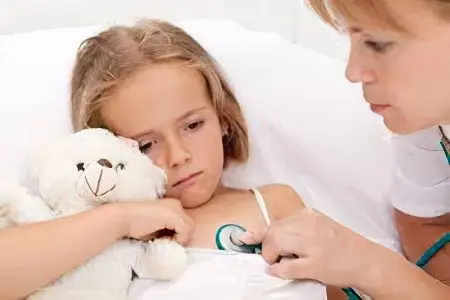Contents

Hepatitis C is an infectious inflammatory disease that affects the liver when infected with the hepatitis C virus (HCV).
HCV differs from other types of viruses in that it is present in the blood serum in small quantities, so the immune system gives a weak and delayed response to infection.
According to statistics from the United States and Western Europe, hepatitis C accounts for 95% of cases of viral hepatitis, including post-transfusion (caused by the transfusion of infected blood).
The hepatitis C virus is very dangerous, it is able to exist in the body in a dormant state for a long time and to change genetically. HCV infects hepatocytes (liver cells), leading to an overgrowth of connective tissue (fibrosis) and necrosis of the liver. Complications of hepatitis C can be vasculitis, encephalopathy, arthritis, as this virus can penetrate into the tissues of the brain, heart, etc.
Causes of hepatitis C in children
The hepatitis C virus is transmitted through the blood. There are two main routes of transmission – parenteral and vertical (from mother to child during childbirth). The frequency of perinatal transmission to a child from an infected mother is about 5%. In the presence of a combination of hepatitis C virus and HIV infection, this figure increases by 3-4 times.
Parenteral routes of transmission:
Various medical manipulations: the use of non-sterile instruments for dental treatment, various kinds of injections; there is a high risk of infection during blood transfusions, hemodialysis, plasmapheresis, if the blood was poorly checked and infected, with various surgical interventions and organ transplantation;
Non-compliance with the rules of personal hygiene: the use of other people’s razors, manicure accessories; hepatitis C virus is transmitted by household means in the presence of microtraumas, through abrasions and cuts;
Procedures associated with damage to the skin: tattoos, piercings made in dubious establishments;
Repeated use of syringes for intravenous administration of narcotic drugs;
Unprotected sex, especially during menstruation.
Types of hepatitis C
According to the duration of the flow, they distinguish:
Acute hepatitis (up to 3-6 months);
Chronic hepatitis (more than 6 months). The chronic form can be a consequence of an acute disease, but in most cases the chronic process is primary. The disease is characterized by a long progressive course and causes serious liver damage: cirrhosis, liver failure, malignant tumors.
Depending on the clinical symptoms, there are:
Typical acute form, accompanied by signs of jaundice;
Atypical (anicteric form), which is much more common in children.
Symptoms of hepatitis C in children

The incubation period averages 5-8 weeks. The disease develops gradually, its first signs may appear even 6-12 months after infection. In acute hepatitis C, there is an astheno-vegetative syndrome, pain in the abdomen and joints, an increase in temperature for a long time up to 37-38 ° C; urine becomes dark and frothy, feces become discolored. Intoxication of the body is accompanied by nausea, vomiting.
Signs of jaundice (yellowing of the skin, sclera of the eyes and oral mucosa) in children do not always appear, but only in 20-40% of cases, and last 2-3 weeks. Jaundice in hepatitis C has milder manifestations than in other types of hepatitis. The acute course of the disease is observed in 10-20% of cases, and then usually becomes chronic. At the same time, the child’s well-being returns to normal, the liver can be slightly enlarged and compacted.
Chronic hepatitis C is usually asymptomatic, sometimes for many years. Against the background of a relatively satisfactory state of health of the child, hepatomegaly (enlargement of the liver) is diagnosed, in 60% of cases – also splenomegaly (enlargement of the spleen). In 35% of children with chronic hepatitis C, fatigue, asthenia, weakness, gastrointestinal upset, telangiectasias (“spider veins” on the body) are observed.
The chronic form of the disease is cyclic in nature, when exacerbation phases are replaced by remission phases, and is often detected by chance.
Diagnosis of hepatitis C in children
HCV is diagnosed based on the results of biochemical and serological tests. In the blood with HCV, there is always an increased level of ALT and ACT enzymes, sometimes an increase in bilirubin. Serological testing (ELISA) confirms the presence of antibodies in the blood, helps to determine the activity of the virus, the stage of the disease, the duration of infection.
A PCR study can detect HCV RNA in the blood 3-4 days after infection, when antibodies have not yet formed. The PCR method determines the genotype and concentration of the virus in the blood. The higher the concentration, the worse the prognosis. Most often in children, HCV genotype 1b is found, which is characterized by a 90% transition to the chronic stage and a rather severe course.
Hepatitis C in children must be differentiated from other viral hepatitis (primarily from hepatitis B), hemolytic disease, obstructive (mechanical) jaundice.
Additionally, an abdominal ultrasound may be performed. In some cases, a liver biopsy is required.
Treatment of hepatitis C in children

Hepatitis C in children is treated in the same way as other types of viral hepatitis. Treatment includes taking antiviral drugs, immunomodulators, symptomatic therapy (elimination of clinical manifestations of the disease). It is recommended to stay in bed and follow a diet.
In the chronic form of hepatitis (and in order to prevent the transition of the disease to the chronic stage), interferon preparations are used: viferon, roferon A, intron A, as well as ribavirin and interferon inducers (cycloferon). For children aged 3-17 years, in the absence of contraindications, recombinant interferon-alpha (IFN-a) is prescribed in combination with ribavirin or separately.
The treatment regimen is determined individually depending on the severity of the process and other factors. The duration of treatment is on average from 6 months to a year. In malignant forms, corticosteroid hormones are prescribed.
Also, in chronic hepatitis, ursosan can be used – a drug that has an immunomodulatory, anti-cholestatic, antioxidant effect. It is taken in parallel with interferon or as monotherapy.
Side effects of antiviral therapy can be changes in blood composition, minor gastrointestinal disorders, headaches and muscle pain, fever, general weakness, dry skin, hair loss. But as the body gets used to the drugs, the well-being of patients improves.
To alleviate the condition and remove the toxic load from the liver, auxiliary therapy can be prescribed, including the use of hepatoprotectors (Essentiale forte, carsil, silimar) and sorbents (enterosgel, activated charcoal).
Prognosis and prevention
The prognosis of the disease varies widely. The acute form of hepatitis C with adequate therapy can be completely cured within a year. The chronic process can stretch for decades and lead to cirrhosis. In severe, complicated forms of the course of the disease and the development of a malignant process, there is a risk of death.
Prevention measures include:
Use of sterile or disposable medical instruments (syringes, dental instruments, catheters);
Rigorous examination and testing of blood for transfusion and its preparations;
Following the rules of personal hygiene;
The fight against child drug addiction.









